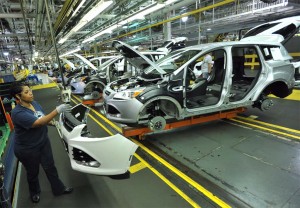With the formal production launch of its new Escape crossover-utility vehicle, Ford Motor Co. caps off a $600 million investment in its Louisville assembly plant, converting a traditional truck facility with limited flexibility to one that can handle six different car-based models simultaneously.
The project was meant to address several problems facing the automaker. Among other things, the massive factory will now be able to more rapidly adapt to shifts in market demand. But equally important, it is part of a broader effort by Ford to catch up to the surging U.S. market. Company officials have been warning that Ford is likely to lose sales and market share this year because it is running short of capacity after years of factory cutbacks.
“Louisville Assembly Plant’s reinvention illustrates how Ford is going further, continuing to invest in American manufacturing and new jobs,” proclaimed Ford President of the Americas Mark Fields, “while delivering even more of the fuel-efficient vehicles that give customers true power of choice.”
The new Escape, already earning strong reviews from, among others TheDetroitBureau.com, is generally expected to pick up share in the rapidly expanding compact crossover market – that is, if Ford can meet demand for the CUV which, for 2013 migrates from a conventional, truck-like design to one using a car-based platform.
That won’t be as easy as it might seem. In fact, Ford is facing a number of capacity challenges as the U.S. automotive market recovers. Competitor Toyota upped its forecast for 2012 to 14.4 million – about 500,000 units ahead of what most analysts had originally expected and 1.5 million beyond 2011 sales.
But Ford, in particular, could pay the price of prudency. Going into the recent Great Recession the maker made a serious effort to boost capacity utilization at key plants while closing others, such as the aged Twin Cities line in Minneapolis that produced the now-abandoned Ranger pickup.
“We’ll take a hit in the short-term…because we’re limited in production,” Ford CEO Alan Mulally warned late last month, adding that “We really can’t make as many vehicles as people want right now.”
That’s a doubly serious problem because not only can’t Ford keep pace with the automotive recovery – it has been lagging behind the overall market for months – but it risks giving momentum to its key Japanese rivals, Toyota and Honda in particular, just as they are recovering from their own shortages caused by last year’s Japanese earthquake and tsunami.
Ford wasn’t caught completely off guard. It had already planned to increase capacity when it promised to add thousands of new jobs as part of its new contract negotiated last year with the United Auto Workers Union.
So far this year, it has added 5,200 jobs and plans to boost that to 12,000 by 2015 – with a strong possibility that could go higher if the economy and auto sales, in particular, pick up momentum.
The Louisville plant has already gotten 1,800 new workers to man a second shift, with another 1,300 coming aboard when a third shift is launched before year-end.
Part of the challenge for Ford is that many of its suppliers, such as Magna International, also responded to the recession by cutting capacity and are now struggling to meet their own customer needs.
Ford has so far added jobs at five plants but, like its competitors, it is doing so cautiously. “Nobody wants to pull the trigger too soon” and risk adding new shifts or worse, new plants, if the economy falters again, said auto analyst John McElroy, host of the Autoline: Detroit TV program.
Nonetheless, Ford is convinced it has to expand and is now moving to add about 400,000 units of annual capacity with moves like the ones it has taken in Louisville.
Key to that strategy has been a near decade-long shift from dedicated factories that were designed to focus on just one or two models to more flexible facilities. Louisville, for example, previously built the old, truck-based Explorer. It can now handle car-based Escape and five other models to come.
That means Ford can roll out lower-volume products that might not have been cost-effective before. And it can rapidly adjust volumes to reflect shifting demand. If one model slides on the sales chart the maker can boost production of other, more popular vehicles.
“Manufacturing flexibility is critical to staying competitive in today’s global automotive marketplace,” said Jim Tetreault, Ford vice president of North America Manufacturing. “Our ability to produce up to six vehicles from a single plant gives us a sizable advantage in quickly adjusting our products and volumes to match changes in customer preferences and market factors.”

